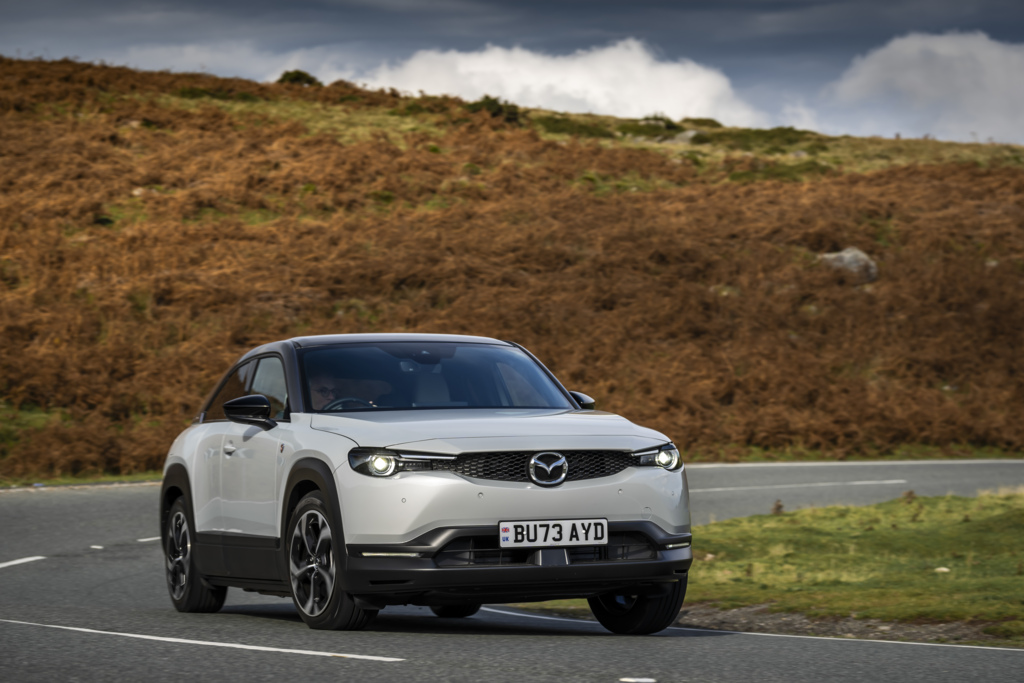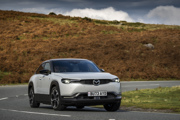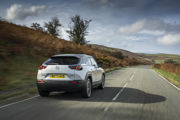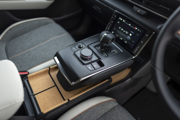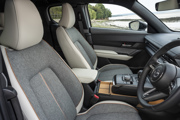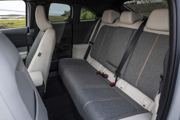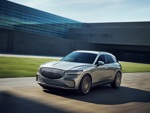Review
Mazda has never been shy of breaking barriers and its use of a petrol rotary engine to create a range-extender electric vehicle version of its MX-30 is testament to that. Building on the quality and undoubted charm of the original car, the powertrain offers a BEV-like driving experience but with the extra range and convenience of a traditional plug-in hybrid, broadening the appeal of what was already a likeable package.
Overview
When Mazda launched the MX-30 crossover - its first fully-electric model - in the UK in 2021, it won plenty of plaudits for its quality and engaging drive. However, its WLTP range of just 124 miles limited its appeal to many potential customers.
Two years later Mazda has launched a model to address this issue: the MX-30 R-EV range-extender plug-in hybrid, which uses a small rotary petrol engine as a generator to both charge a drive battery and provide power to its electric motor.
Available in three trim levels, P11D prices start at £31,195 for the entry-level Prime-Line model, rising to £35,945 for the range-topping Makoto.
The manufacturer expects the mid-range Exclusive-Line to be the most popular model, accounting for 44% of registrations.
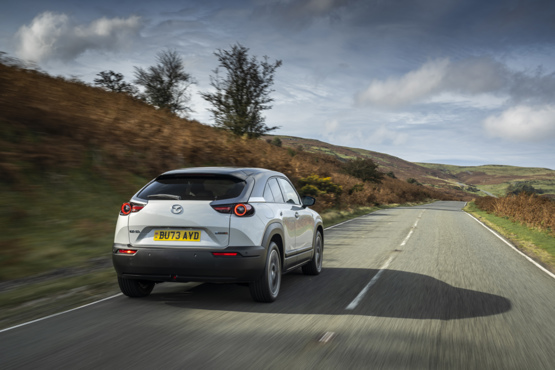
Comfort and practicality
As well as its innovative powertrain, MX-30 R-EV also has another significant departure from the norm when it comes to practicality – rear 'suicide' doors.
Also featured on the BEV model, these see the rear doors hinged at the back to create a wide open space to enter and exit the cabin – the design means there no centre pillar between the front and back seats. However, it also means the rear doors cannot be opened unless the front doors are.
Once in the back, legroom and headroom is good for this size of car but as it has small rear side windows, which cannot be opened, some occupants may find it slightly claustrophobic.
Front seat occupants fare much better: there is plenty of room and their seats offer plenty of support and adjustment.
The quality of design and build seen throughout the cabin are the typical of the high standards found in other Mazdas, while there is a wide mix of colours and materials – from cork left over from the production of bottle stoppers which also harks back to the original formation of Mazda as a cork company, to fabric created from recycled plastic bottles – used to lift the ambience of the cabin.
Boot size is 350 litres.

Safety and technology
All MX-30s come with a good level of comfort and safety equipment.
Standard safety gear across all models includes blind spot monitoring, driver attention alert, and lane-keep assist with lane departure warning.
Makoto trim adds driver monitoring, front cross traffic alert and smart brake support – rear/rear crossing.
All models also feature two centrally-mounted screens for infotainment and heating functions.
The top one – an 8.8-inch widescreen - is operated through a rotary dial and buttons and is used for functions such as navigation, vehicle settings and entertainment.
At the bottom of the centre console is the second screen. This one is touchscreen and serves as a control panel for the air-conditioning.
Both displays are crisp and complement the digital instrument cluster.
The system works well and is intuitive to use: it adds a premium feel and also avoids the all-too common issue of having to hunt through numerous touchscreen menus to find the function you want.
Driveability and range
MX-30 R-EV offers just one powertrain option, which combines an 830cc rotary petrol engine and 17.8kW battery in a range-extender system.
As there is no mechanical connection between the engine and the driven wheels, the engine simply acts to either charge the battery or provide power to the 170PS electric motor.
When full, the battery can provide a WLTP electric-only range of 53 miles, although how much of the charge which is used before the petrol engine kicks in to charge in is up to the driver.
In electric driving mode, the car depletes the battery fully before the engine fires up to generate electricity. Normal mode sees the battery run down to 43% before starting it, while a third mode – charge – is available and allows the driver to select the amount of energy they want to charge the battery to - and maintain it at.
On the road, the MX-30 R-EV behaves like most other Mazdas. The ride strikes a good balance between comfort and sportiness, and proved settled over some pretty horrible road surfaces on the test route.The steering is well-weighted and responsive to provide an engaging drive.
The innovative powertrain is smooth in operation. As the petrol engine does not directly drive the wheels, the MX-30 performs like a refined BEV at all times, whether the engine is generating power or not.
There are no perceptible gear shifts such as those you experience in a normal plug-in hybrid, and when the engine starts to either charge the battery or boost power under hard acceleration the interaction is seamless.
The only sign the engine is running is its noise, and although this can be an unfamiliar droning sound at constant low speeds, it is largely drowned out when listening to the radio at normal levels.
The MX-30 R-EV has a 50-litre petrol tank and unlike traditional PHEVs, it can be plugged into a DC rapid charger, reducing the time spent at the charge point.
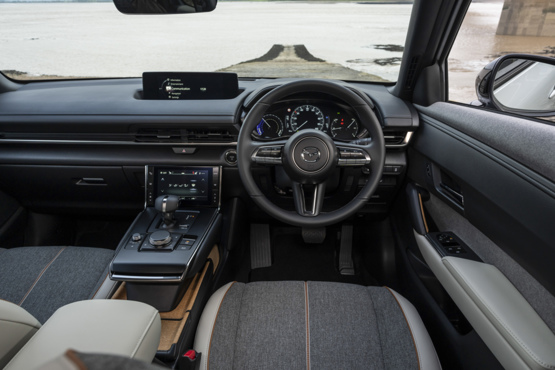
Company car tax and running costs
For users wanting a PHEV-type powertrain, the MX-30 R-EV has plenty of appeal on the cost sheet, with a P11D price around £5,000 less than any PHEV.
All MX-30 R-EVs attract an 8% benefit-in-kind tax rate, putting them on a par with traditional PHEVs, with drivers (20% taxpayers) facing monthly BIK bills of between £42 and £48.
Across the line-up, running costs range from 31ppm to 36ppm.
The MX-30 R-EV is also almost identically priced to its BEV sibling. The Prime-Line and Exclusive-Line models cost exactly the same, while the Makoto BEV carries a £500 premium.
Charging times
3-pin plug: 4hr 50mins
7kW wallbox: 1hr 30mins
11kW AC: 50mins
36kW rapid: 25m (20% to 80%)
Specs
| Manufacturer | Mazda |
| Model | MX-30 Hatchback |
| Specification | Mazda MX-30 Hatchback 125kW R-EV Exclusive Line 5dr Auto |
| Model Year | 2023.00 |
| Annual VED (Road tax) | £110 |
| BIK List Price | £33,440 |
| Range | 53.00mile(s) |
| CO2 | 21g/km |
| BIK Percentage | 8% |
| Insurance Group | N/A |
| CC | 1 |
| Fuel Type | Electric Petrol REX |
| Vehicle Type | Compact SUV |
| Luggage capacity (Seats up) | 350litres |
| Doors | 5 |
Running Costs
| P11D | £33,440 |
| Cost per mile | 39.79ppm |
| Residual value | £12,800 |
| Insurance group | N/A |
| Fuel Type | Electric Petrol REX |
| Cost per mile | 146.27ppm |
| Fuel | 2.36ppm |
| Depreciation | 142.95ppm |
| Service maintenance and repair | 0.96ppm |
Info at a glance
-
P11D Price
£33,440
-
MPG
282.5 (WLTP) -
CO2 Emissions
21g/km -
BIK %
8% -
Running cost
3 Year 60k : £12,800 4 Year 80k : £10,425 -
Fuel Type
Electric Petrol REX -
Range
53.00mile(s)



